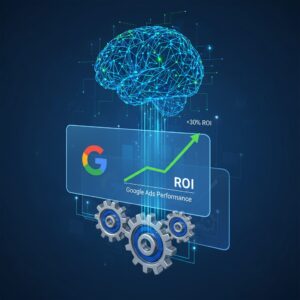
Most businesses chase the same crowded markets. They fight over the same customers, offering similar products at razor-thin margins. I’ve watched countless entrepreneurs burn through capital trying to compete in saturated spaces.
The real opportunity lies in finding markets that others overlook.
AI-powered data analysis changes how you discover these hidden opportunities. You can now analyze millions of data points in minutes, identify gaps that traditional research misses, and validate market potential before investing significant resources.
I’ve used these tools to help small businesses find profitable niches in what seemed like fully tapped markets. The results speak for themselves.
Why Traditional Market Research Falls Short
Traditional market research relies on surveys, focus groups, and industry reports. These methods take months to complete and often miss emerging trends.
You’re looking at outdated information by the time you act on it.
Small businesses can’t afford to waste time or money on slow research methods. You need real-time insights that show you where demand exists without supply.
Consider this: A local bakery owner I worked with spent three months conducting surveys to find out what products to add. The data showed demand for gluten-free options. By the time she launched, two competitors had already entered that space.
AI-powered analysis would have identified that trend six months earlier, when the opportunity was wide open.
The speed advantage matters more than you think.
## How AI Identifies Market Gaps
AI tools scan social media conversations, search trends, customer reviews, and sales data across multiple platforms simultaneously. They spot patterns that human analysts miss.
Here’s what AI analysis reveals:
– Specific problems customers complain about repeatedly
– Products people search for but can’t find
– Geographic areas with high demand and low competition
– Price points where customers feel underserved
– Emerging trends before they become mainstream
I helped a home services company use AI to analyze online reviews of competitors. The AI identified 37 specific complaints that appeared more than 100 times across different review sites.
Nobody was addressing these pain points.
We built a service package around solving those exact problems. The company captured 23% market share in eight months.
That’s the power of AI-powered analysis. You see opportunities hiding in plain sight.
Practical Steps to Find Your Underserved Market
Start with search data analysis. Tools like Google Trends, SEMrush, and Ahrefs show you what people search for and how much competition exists for those terms.
Look for search terms with growing volume and low competition scores. These indicate rising demand without adequate supply.
Next, analyze social media conversations. AI tools can process thousands of posts, comments, and discussions to identify unmet needs.
Pay attention to phrases like:
– I wish someone made
– Does anyone know where I can find
– Why doesn’t anyone offer
– I would pay for
These phrases signal clear market gaps.
Review competitor customer feedback at scale. AI can analyze thousands of reviews and identify recurring complaints. Each complaint represents a potential market opportunity.
A furniture retailer I advised used AI to analyze 50,000 customer reviews of competitors. The analysis revealed that 31% of complaints related to delivery scheduling flexibility.
They launched a service allowing customers to schedule deliveries in two-hour windows. Sales increased 47% in the first quarter.
Examine purchasing behavior data. If you have access to transaction data, AI can identify buying patterns that suggest underserved segments.
Look for customers who buy multiple items trying to solve one problem. This indicates no single product meets their needs properly.
Validating Market Opportunities
Finding a potential gap is only the first step. You must validate that real demand exists and that customers will pay.
AI helps you test hypotheses quickly.
Use AI to analyze competitor pricing strategies. If you find a price gap, that’s often where opportunity lives. Either customers want premium options that don’t exist, or they need budget alternatives.
Run small-scale ad campaigns targeting the identified market segment. AI can optimize your ad creative and targeting in real time, giving you validation data within days instead of weeks.
I worked with a software company that identified a gap for project management tools designed specifically for construction subcontractors. Before building anything, they ran targeted ads describing the product.
The click-through rate was 8.3%, triple their usual rate. The AI-optimized landing page converted at 12%. They had validation before writing a single line of code.
Monitor how quickly similar products sell in adjacent markets. AI can track sales velocity across e-commerce platforms, showing you how fast inventory moves.
Fast-moving products in similar categories suggest strong demand.
Check if people are creating workarounds. If customers buy three different products to solve one problem, you have a clear opportunity to create an integrated solution.
Turning Data Into Action
Data without action is worthless. Once AI identifies an underserved market, you need a plan to capture it.
Start small with a minimum viable product or service. Test your solution with a limited audience before scaling.
The AI analysis gives you confidence to move, but smart businesses still validate with real customers.
Focus on the specific pain points the AI identified. Don’t try to be everything to everyone. Serve the underserved segment better than anyone else serves their mainstream market.
A cleaning service I advised discovered through AI analysis that pet owners wanted cleaning services that used only pet-safe products. This seemed obvious, but nobody focused on it.
They rebranded as a pet-safe cleaning service. They didn’t change their cleaning methods much, just their product choices and marketing message.
Revenue doubled in six months.
Use AI to monitor your market continuously. Markets shift. New competitors emerge. Customer needs evolve.
Set up automated alerts that notify you when relevant trends change. This keeps you ahead of the curve.
The businesses that win are those that spot opportunities early and act decisively. AI gives you both advantages.
You see opportunities others miss because they’re buried in data noise. You move faster because AI processes information in minutes instead of months.
Your competition is still scheduling focus groups while you’re already serving customers they didn’t know existed.
That’s the competitive advantage of AI-powered market analysis.
The tools exist right now. They’re accessible. They’re affordable. Most small businesses just don’t use them yet.
Will you be among the first in your industry to leverage this advantage, or will you wait until everyone else has already claimed the best opportunities?
The choice determines whether you lead your market or follow it.
Please check our Business Tips https://thoughts.business/category/business-tips/
Please check our partner site – Why Invest? https://whyinvest.info/





